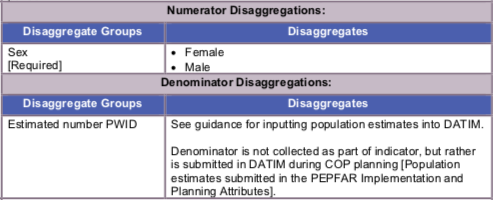(KP_MAT_NAT) Percentage of people who inject drugs (PWID) on medication assisted therapy
Export Indicator
Medication assisted therapy programs should be an access point for PWID and the program should refer and link to ARV treatment programs, PMTCT for female PWID and a range of other prevention services.
It is important to know how many people are reached in order to monitor how well programs are reaching PWIDs with medication-assisted treatment. This information can be used to plan and make decisions on how well the PWID audience is being reached with medication- assisted treatment. If a small percentage of the intended audience is being reached, then it would be recommended that activities are adjusted to improve reach. If a large percentage of the intended audience is being reached, then headquarters staff would want to take these lessons learned and disseminate them to other countries. The country can use the information to improve upon the quality of the program as well as scale-up successful models.
This indicator is harmonized with GAM indicator “Percentage of people who inject drugs receiving opioid substitution therapy.”
Number of people who inject drugs (PWID) on medication assisted therapy
Estimated number PWID
How to collect:
The numerator is generated by counting the total number of individuals who have been on treatment for at least 6 months since initiation of medication-assisted treatment (e.g., using methadone or buprenorphine to treat drug dependency) at any point in time within the reporting period. The numerator should equal the number of adults who initiated and remain on medication-assisted treatment for at least 6 months prior to the end of the reporting period.
Reporting level: National and Sub-national: Data should be entered for all SNUs, regardless of PEPFAR- funded support for these geographical areas; so that the total of the sub-national number should equal the total number of national number.
Reporting frequency: Annually

Indicator changes (MER 2.0 v2.3 to v2.4): None
Data entered by: This data should be entered in DATIM by the USG country team.
Guiding narrative questions:
- Narratives should include information on how national and subnational totals have been derived for results.
- Narratives should discuss the national policy environment and future plans for MAT at the national level.